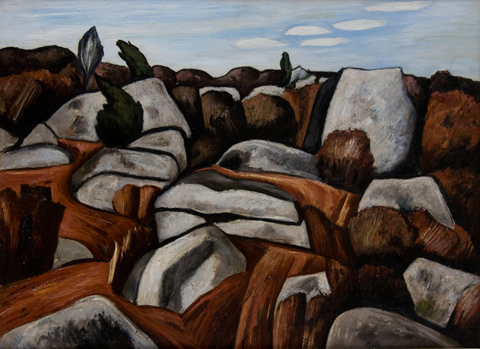
ROCK DOXOLOGY In Gloucester 1931, Marsden Hartley pioneered his late, raw, direct style. |
Marsden Hartley returned to Gloucester in 1931 like so many traditional painters making the summer pilgrimage to the city's shores and fishing wharves, except he was part of Alfred Stieglitz's Modernist circle in New York, had imbibed French Cubism in Paris and German Expressionism in Berlin, and was a friend of Gertrude Stein and Wassily Kandinsky.
> SLIDESHOW: ''Marsden Hartley: Soliloquy in Dogtown'' + Cristi Rinklin's ''Diluvial'' <
The Maine-born Hartley arrived from New York that July recovering from a winter bout of bronchitis, losing his hearing, depressed, a frustrated visionary, not having painted in nearly a year. He was a balding, hound-dog-faced, sunken-eyed, lonely gay man still harboring a thing for Aryan youth, like the German lieutenant "friend" who he'd lost in the fighting of World War I. He was deeply isolated and alienated.
But a 1920 glimpse of Gloucester's undeveloped center glimmered in his mind. "I had remembered the rocks and the name Dogtown — that's a great name," he wrote in his autobiography, "and in all the years of Gloucester painting celebrity no one ever had done anything about Dogtown."
In his typical contrary way, the 54-year-old turned away from the waterfront where he lodged and each afternoon hiked five miles into Dogtown, a colonial settlement that had been abandoned in the mid 18th century, and by some accounts nicknamed for stray dogs that departing residents left behind. Today it's gone wild again with forest, but in Hartley's era it remained open grazing pastures with stone walls, fields of boulders believed scattered by the glaciers of the last ice age, and here and there cellar holes of the ghost town.
"Marsden Hartley: Soliloquy in Dogtown" at the Cape Ann Museum (27 Pleasant St, Gloucester, through October 14) reveals in 13 paintings and 13 drawings the breakthrough he made that summer, as he extended his stay into the fall, and pioneered his late, raw, direct style. He painted dirt paths rambling past old wood fences and placid summery green, boulder-strewn fields. By October, he was excitedly writing, "I have never seen anything so unique as the coloring is up on the Cape just now. It comes the closest to the analogy of music that I have ever seen."
I suspect it had something to do with the way green lichen-speckled boulders in fall suddenly contrast with the now-orange foliage. In Wind-Bitten Moors, Dogtown, a burnt brown pasture is dotted by sentinel boulders. In Rock Doxology, steel-gray rocks seem to block every path through the rusty orange grass and shrubs. You feel the mass of the granite, the geologic time. Hartley merges the fractured surfaces of Cubism and the darkness of German Expressionism with a flinty, chiseled Yankee folksiness to describe fierce, ecstatic, claustrophobic, alien landscapes.
Dogtown in fact was open and pastoral, as John Sloan conveys in a 1916 landscape hanging in an adjoining gallery. Hartley's accomplishment — which would fuel his later works — was to suffuse it with his psychological charge. It's not just Dogtown, it's Dogtown as Hartley felt it.